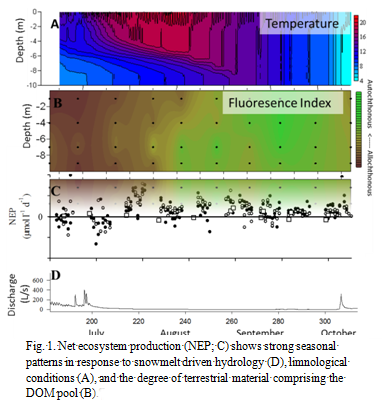Linking lakes to the landscape: mechanisms that control terrestrial subsidies to pelagic food webs (NSF Postdoctoral Fellowship, S. Sadro 2013-2015)
There are three possible mechanisms through which terrestrial carbon may enter pelagic food webs: 1) direct consumption of particles by zooplankton; 2) osmotrophic uptake of dissolved organic carbon (DOC) by zooplankton; or 3) microbial uptake of DOC and subsequent consumption of microbes by zooplankton, either directly or through protozoans. Dissolved organic matter (DOM) is the dominant pool of reduced carbon in aquatic ecosystems, and heterotrophic bacterioplankton are the primary consumers of DOM in pelagic habitats. This project seeks to understand how variability in the concentration and composition of terrigenous inputs affect the transfer of terrestrial carbon into pelagic food webs.
Background
Ecosystem metabolism of high-elevation lakes is dominated by heterotrophic bacterioplankton (Sadro et al. 2011c). Net metabolic balance of these lakes changes seasonally in response to snowmelt dynamics, DOM composition, and limnological conditions (Fig. 1; Sadro et al. 2011a, Sadro et al. 2011b). The fluorescence index (FI), a relative measure of allochthonous and autochthonous fulvic acids in the dissolved organic matter pool, indicates there are three statistically distinct phases in the seasonal composition of DOM (Fig. 2). Early in the ice-free season during spring snowmelt, when DOC fluxes are highest and DOM fluorescence suggests material is largely terrestrial, the lake is predominantly heterotrophic and more carbon is being respired than fixed through primary production (Fig. 1). With the onset of summer stratification and increase in phytoplankton biomass, the lake shifts to be predominantly autotrophic and terrestrial DOM is gradually replaced by DOM of autochthonous origin.
Research Plan
Hypothesis I: The timing of snowmelt will have a key role in modulating the rate at which pelagic food webs are subsidized by terrestrial organic matter.
Hypothesis I will be tested by tracking changes in the natural abundances of δ13C, δ2H and Δ14C in relation to seasonal changes in hydrology, biogeochemistry, and aquatic primary producer biomass from a representative Sierran lake and its catchment. Similarly, sub-hypothesis IIa will be tested through a comparative study of natural abundances of δ13C, δ2H and Δ14C among five different lakes from catchments spanning a gradient in vegetation cover and soil development representing different degrees of potential terrestrial influence. Sub-hypothesis IIb and IIc will be tested by experimentally manipulating soil collected from different landscape types and measuring differences in the natural abundances of δ13C, δ2H and Δ14C among limnocorral treatments containing complete food webs.
Hypothesis II: By influencing the quality and quantity of terrestrial organic matter inputs, landscape characteristics such as soil development and vegetation type will be important drivers of terrestrial subsidies to pelagic food webs.
For Hypothesis II, the magnitude of terrestrial subsidy will be related to organic matter quality based on the fluorescence characteristics and elemental composition of organic matter.
Hypothesis III: The balance between particulate and dissolved organic matter concentrations will mediate the relative proportion of terrestrial carbon flow to zooplankton through the three possible mechanistic pathways.
Hypothesis III will be tested by comparing δ13C, δ15N, δ2H and Δ14C signatures of various source materials with that found in zooplankton in relation to concentrations of dissolved and particulate organic matter found in lakes. Sub-hypothesis IIIc will be tested by experimentally restricting the organic matter source available to zooplankton to the dissolved fraction and measuring changes in the natural abundances of δ13C, δ15N, δ2H and Δ14C among treatments.

